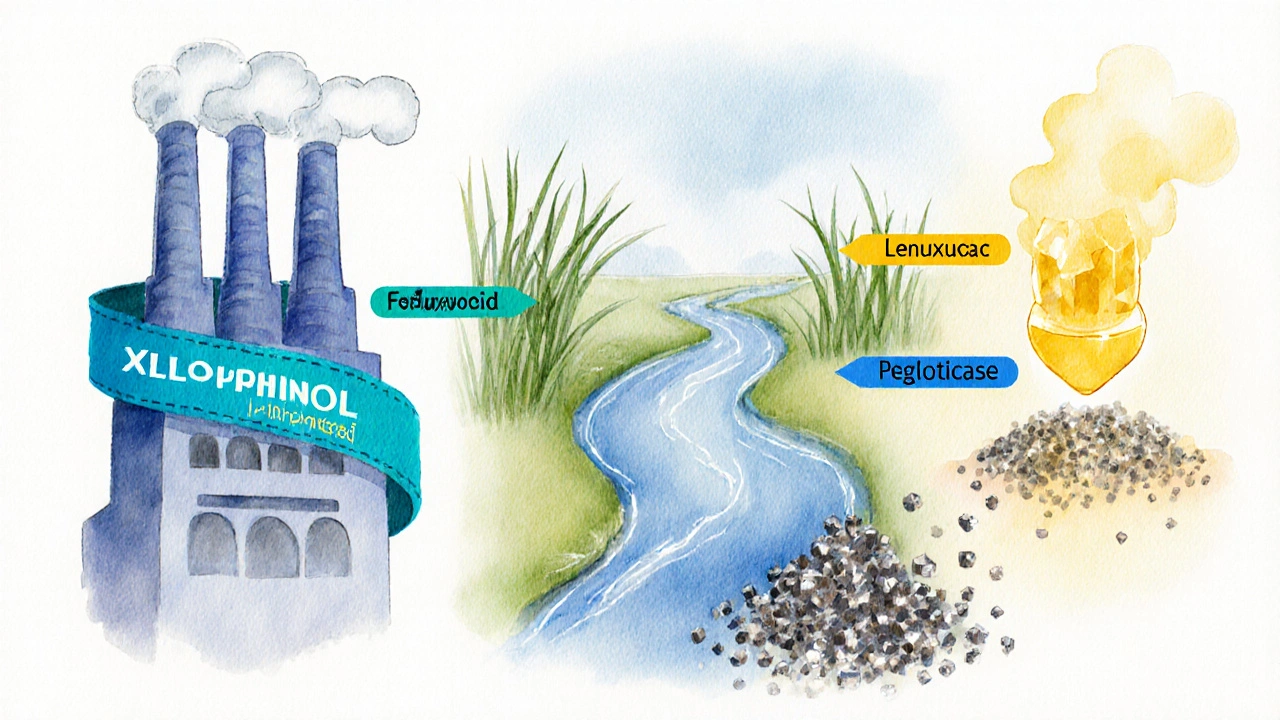Gout Medication Comparison Tool
Allopurinol (Zyloprim)
First-line xanthine oxidase inhibitor
- Rash Risk
- Liver Enzyme Elevation
- Stevens-Johnson Syndrome
Febuxostat (Uloric)
Alternative xanthine oxidase inhibitor
- Cardiovascular Risk
- Mild Liver Changes
- Rash
Probenecid
Uricosuric drug increasing excretion
- Kidney Stones
- GI Upset
- Drug Interactions
Lesinurad
URAT1 inhibitor, add-on therapy
- Renal Adverse Events
- Increased Creatinine
- High Dose Risk
Pegloticase
IV enzyme for severe cases
- Infusion Reactions
- Immunogenicity
- High Cost
Cost Comparison
Allopurinol: Under $10/month (generic)
Febuxostat: ~$80-$300/month (depending on version)
Probenecid: Very affordable (~$5-$10/month)
Lesinurad: ~$1,000/month
Pegloticase: ~$3,000+ per infusion
Best For
Allopurinol: First-line therapy for most patients
Febuxostat: Patients with rash or limited kidney function
Probenecid: Patients with good kidney function
Lesinurad: Resistant cases with other drugs
Pegloticase: Severe, uncontrolled gout
If you’ve been diagnosed with gout, the first question that pops up is “which drug will keep my uric acid in check without turning my life upside‑down?” Allopurinol alternatives are a hot topic because the classic pill works for most people, but a sizable slice of patients run into side‑effects, drug interactions, or simply don’t hit the target uric‑acid level. Below you’ll find a side‑by‑side look at Zyloprim (Allopurinol) and the most common substitutes, so you can see which one fits your health profile, lifestyle, and budget.
Quick Take
- Allopurinol is a xanthine oxidase inhibitor; it’s first‑line for most gout patients.
- Febuxostat offers similar potency with a lower risk of certain skin reactions but costs more.
- Probenecid works by increasing uric‑acid excretion; great for patients with good kidney function.
- Lesinurad is used only in combination with a xanthine oxidase inhibitor, mainly for resistant cases.
- Pegloticase is an IV enzyme reserved for severe, refractory gout.
How Allopurinol Works
Allopurinol is a xanthine oxidase inhibitor that blocks the enzyme responsible for turning purines into uric acid. By curbing production, it gradually lowers serum uric‑acid levels, usually within 2-4 weeks of steady dosing. The standard starting dose is 100mg daily, titrated up to 300mg or higher based on blood tests and kidney function.
Because it works upstream, Allopurinol is effective for most types of hyperuricemia, the medical term for elevated uric‑acid levels that drive gout. Most guidelines list it as the first‑line therapy for chronic gout management.
Major Alternatives at a Glance
When Allopurinol isn’t a good fit, doctors turn to four main alternatives:
- Febuxostat - another xanthine oxidase inhibitor, approved in 2009, that can be used when Allopurinol causes rash or when kidney function is limited.
- Probenecid - a uricosuric drug that increases renal excretion of uric acid; best for patients with normal kidney function.
- Lesinurad - a selective uric‑acid transporter (URAT1) inhibitor, approved only as an add‑on to a xanthine oxidase inhibitor for refractory cases.
- Pegloticase - a recombinant uricase enzyme given intravenously; reserved for severe, uncontrolled gout.
Side‑Effect Profiles you’ll want to know
Every gout drug carries its own risk bundle. Below is a quick snapshot:
- Allopurinol: rash (including rare Stevens‑Johnson syndrome), liver enzyme elevation, hypersensitivity especially in patients with HLA‑B*58:01.
- Febuxostat: elevated cardiovascular risk in some studies, mild liver enzyme changes, rash.
- Probenecid: kidney stones, gastrointestinal upset, drug‑drug interactions (e.g., with antibiotics).
- Lesinurad: renal adverse events, especially when combined with high‑dose Allopurinol; increased serum creatinine.
- Pegloticase: infusion reactions, immunogenicity, and high cost.
Cost and Accessibility
Price matters for long‑term therapy. Generic Allopurinol is usually under $10 per month, making it the most affordable option. Febuxostat’s brand name (Uloric) sits around $250-$300 monthly, though a generic version launched in 2024 drops it to roughly $80. Probenecid is inexpensive (<$20/month) but limited by kidney function requirements. Lesinurad (Zurampic) costs about $150/month, and Pegloticase (Krystexxa) can surpass $10,000 per infusion course.

Comparison Table
| Drug | Mechanism | Typical Dose | Key Benefits | Major Risks | Cost (US, 2025) |
|---|---|---|---|---|---|
| Allopurinol | Xanthine oxidase inhibition | 100‑300mg daily | First‑line, well‑studied, cheap | Hypersensitivity, rash | ≈ $10/month |
| Febuxostat | Xanthine oxidase inhibition (non‑purine) | 40‑80mg daily | Effective in renal impairment, fewer skin reactions | Cardiovascular warnings | ≈ $80/month (generic) |
| Probenecid | Uricosuric (URAT1 blocker) | 250‑500mg twice daily | Works when production inhibitors fail | Kidney stones, drug interactions | ≈ $15/month |
| Lesinurad | Selective URAT1 inhibition (add‑on) | 200mg daily with xanthine oxidase inhibitor | Adds ~20% extra uric‑acid lowering | Renal function decline | ≈ $150/month |
| Pegloticase | Recombinant uricase (converts uric acid to allantoin) | 8U IV bi‑weekly | Rapid, dramatic uric‑acid drop | Infusion reactions, high cost | ≈ $10,000/infusion series |
How to Pick the Right Drug for You
Choosing isn’t just about numbers; it’s about your whole health picture. Ask yourself these quick questions:
- Kidney function: If eGFR < 30mL/min, Allopurinol dose must be reduced and Febuxostat becomes attractive.
- History of rash or hypersensitivity: Patients with HLA‑B*58:01 should avoid Allopurinol; Febuxostat or Probenecid may be safer.
- Cardiovascular disease: If you have recent heart failure, weigh Febuxostat’s warnings against Allopurinol’s profile.
- Cost constraints: Generic Allopurinol or Probenecid usually win the budget battle.
- Severity of gout: Chronic tophaceous gout that refuses standard therapy may need Pegloticase.
Bring this checklist to your next appointment. Your doctor will order baseline labs (serum uric acid, liver enzymes, kidney function) and may test for HLA‑B*58:01 if you’re of Asian ancestry - a smart move before starting Allopurinol.
Monitoring and Follow‑Up
Regardless of the drug you land on, regular monitoring is non‑negotiable. Most clinicians check serum uric acid two weeks after dose changes, then every 3-6 months once stable. Keep an eye on liver enzymes for Allopurinol and Febuxostat, and watch for signs of kidney stones on Probenecid.
Real‑World Stories
Maria, 58, with chronic kidney disease, started Allopurinol 100mg after a flare. Within three months her uric acid fell from 9.2mg/dL to 6.1mg/dL, and she reported no rash. Her doctor later switched her to Febuxostat because her eGFR dropped to 28mL/min; the switch kept her level under 5.5mg/dL with no cardiovascular events.
James, 45, a marathon runner, tried Probenecid but developed a kidney stone after six months. He switched to Allopurinol and stayed stone‑free, though he needed a modest dose increase to maintain target uric acid.
Frequently Asked Questions
Can I take Allopurinol and Febuxostat together?
No. Both drugs block the same enzyme, so combining them doesn’t add benefit and raises the risk of toxicity. If one fails, switch to the other after a wash‑out period.
What if I miss a dose of Allopurinol?
Take the missed dose as soon as you remember, unless it’s almost time for the next one. Never double‑dose to catch up.
Is Probenecid safe for people on blood pressure meds?
Generally, yes, but Probenecid can increase levels of certain diuretics and ACE inhibitors. Check with your pharmacist before combining.
How long does Pegloticase treatment last?
Pegloticase is given every two weeks for up to six months, though some patients continue longer if they tolerate it and maintain low uric‑acid levels.
Do lifestyle changes matter when I’m on medication?
Absolutely. Reducing purine‑rich foods, staying hydrated, limiting alcohol, and maintaining a healthy weight amplify the effect of any gout drug.
Next Steps
1. Review your latest lab results (uric acid, kidney and liver panels).
2. List any past drug reactions, especially skin rashes.
3. Use the checklist above to narrow down 1-2 candidates.
4. Schedule a visit with your rheumatologist or primary‑care provider and discuss the pros/cons you identified.
5. Ask for a trial period and set a follow‑up date to reassess uric‑acid levels and side‑effects.
With the right data and a clear conversation, you’ll land on the drug that keeps your joints pain‑free without jeopardizing other aspects of health. Remember, gout is chronic - the goal is sustainable control, not a quick fix.


Samantha Dean
October 3, 2025 AT 06:53From a pharmacological standpoint, Allopurinol remains the cornerstone of gout management due to its robust efficacy and well‑established safety profile when appropriately dosed. The presented comparison neatly summarizes the principal alternatives, highlighting both therapeutic advantages and potential drawbacks. It is worth noting that genetic screening for HLA‑B*58:01 can further mitigate the risk of severe hypersensitivity reactions. Overall, the tool offers a pragmatic framework for clinicians and patients alike to make informed decisions.
Vanessa Peters
October 4, 2025 AT 10:53Oh, the drama of a “cornerstone” drug that turns your skin into a living rash! Allopurinol may be cheap, but the specter of Stevens‑Johnson looms like a thunderstorm over every prescription. Why settle for a cheap thrill when the alternatives dance on a tighter safety rope?
John Carruth
October 5, 2025 AT 14:56First, let me commend the effort to lay out the options in a clear, side‑by‑side format; such transparency is essential for shared decision‑making. When we consider Allopurinol, its decades‑long history provides a wealth of real‑world data that no newcomer can yet match. However, the drug is not without its caveats, especially in patients harboring the HLA‑B*58:01 allele, where hypersensitivity can become life‑threatening. Febuxostat enters the scene as a potent alternative, yet its association with cardiovascular events warrants careful cardiovascular assessment before initiation. Probenecid offers a completely different mechanism by enhancing renal uric‑acid excretion, which can be advantageous in patients with preserved kidney function. That said, its propensity to precipitate kidney stones demands prophylactic measures such as adequate hydration. Lesinurad, being a URAT1 inhibitor, is primarily an adjunctive therapy; clinicians must vigilantly monitor serum creatinine to avoid renal compromise. Pegloticase stands apart as an intravenous enzyme, reserved for refractory gout, but the high cost and infusion reactions limit its practicality for most. Cost considerations cannot be overlooked; the under‑$10 monthly price of generic Allopurinol democratizes access, whereas Lesinurad and Pegloticase may be prohibitive for many. Moreover, insurance formularies often influence the feasibility of prescribing newer agents like Febuxostat, despite its generic availability. Patient adherence is another pivotal factor; a once‑daily oral tablet like Allopurinol may encourage better compliance than an IV infusion schedule. Lifestyle modifications, including dietary purine reduction, complement pharmacotherapy across all these agents. It is also vital to individualize dosing based on renal function, as dose adjustments for Allopurinol and Febuxostat can mitigate toxicity. Regular monitoring of serum uric‑acid levels guides titration, ensuring the target is reached without over‑suppression. Finally, shared decision‑making that incorporates patient preferences, comorbidities, and financial constraints yields the most satisfactory outcomes.
Melodi Young
October 6, 2025 AT 19:00Honestly, most people don’t realize that the cheapness of Allopurinol can be a double‑edged sword; you save money but you might end up paying later with hospital visits if you’re unlucky enough to develop a rash.
Tanna Dunlap
October 7, 2025 AT 23:03Choosing a drug solely on price is a slippery slope that disregards the sanctity of patient safety; we have an ethical duty to prioritize efficacy and tolerability above all else.
Troy Freund
October 9, 2025 AT 03:06Just thinking out loud, if you’re on a tight budget and your kidneys are in decent shape, starting with Allopurinol and adding lifestyle tweaks might be the low‑stress path.
Mauricio Banvard
October 10, 2025 AT 07:10Ever wonder why the “generic” label pops up on Allopurinol bottles like a secret handshake? Some say the pharma big‑wigs push the newer, pricier pills so they can keep the cash flow humming, while the old‑school meds get sidelined in the shadows.
Paul Hughes
October 11, 2025 AT 11:13👍
Mary Latham
October 12, 2025 AT 15:16i dunno why everyone hype allopurinol when u can try febuxostat lol its actually better for some ppl.
Marie Green
October 13, 2025 AT 19:20I hear you. Managing gout is tough, especially with cost worries.
TOM PAUL
October 14, 2025 AT 23:23Keep pushing for the best fit-your health journey deserves the right tools.